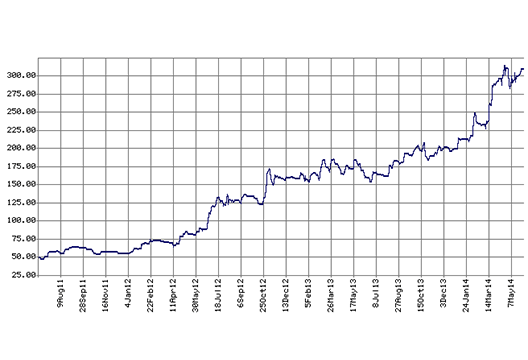|
Parkwalk UK Tech Fund II exits Tracsis at 6.9x
|
|
|||||
 |
Dear We are delighted to have exited our position in Tracsis plc, an AIM-listed Technology Company in the software logistics space, for around 6.9x investor’s gross investment and around 10x their investment when EIS reliefs are taken into account. We invested at 45p per share (31.5p net of initial tax reliefs) and sold our stake at 308.5p after holding the stock for three years. Investors' gains are free from CGT under the EIS. |
|
||||
|
Rather uniquely in this space, this exit allowed us to return substantially more than each investor’s total investment in the Parkwalk UK Tech Fund II, while the other investments are still active and hopefully creating further gains for the Fund at a later stage. This also follows on from two of our portfolio companies floating on AIM in Q1 this year. |
||
|
THE UK TECH SPACE Investor appetite remains strong for University Technology Spin-out companies. After the surge in valuations and the opening of the Public markets in the second half of 2013 there has been something of a retrenchment in the public markets with a tailing off of the number of IPOs but this has not been seen in the private markets where we see many more deals, than at the same time last year, being completed at higher valuations than would have been expected 12 months ago. This is partly because there is more money chasing deals, from HNWs and Angels to EIS and Venture Funds. The end of the tax year saw considerable rises in money raised for EIS and VCT Funds compared to 12 months ago. Interestingly while the Public markets have effectively closed for new small Tech IPOs, the quoted funds that specialise in investing in UK University Technology Spin-outs have or are raising significant amounts of new capital. This indicates that mainstream funds that can mainly invest in public companies still have a strong interest in investing in the sector. PUBLIC FUNDS IP Group, as part of their takeover of Fusion PLC earlier this year, raised £100m on the market, mainly from existing investors at around 2x NAV. IP Group currently have a portfolio of around 70 companies and Imperial a portfolio of around 99 companies. Imperial Innovations announced on Monday the 2nd June that they are raising £150m at £4.00 a share (indicating a pre-money valuation of around £400m). Their stated NAV on 31/1/14 was £255m added to which is the £9m uplift in NAV that came with the IPO of their portfolio company Circassia. This indicates that money is being raised at around 1.5x NAV. Since this announcement Imperial Innovation’s share price has risen to around £4.35 (5/6/14) indicating good support for this share issue. In addition Allied Minds, an American investment company with rights to invest in technology spin-outs from a number of US Universities, has launched an IPO on the LSE to raise $140m. Their model is different to that of IP and Imperial in that they have 18 subsidiary companies, a much more concentrated portfolio, and 195 employees, a much larger organisation. So far they have not had an exit. Alongside these events have been the departure of Neil Woodford from Invesco and the formation of his new funds. We estimated that his exposure to investments in the University Spin-out area, including shareholdings in IP Group, Imperial Innovations and Allied Minds, might have been around £1bn when he was managing the Invesco funds. It has been indicated he will seek to buy some of his private portfolio from Invesco for his new Funds. It has also been indicated that his new funds will continue with an investment strategy similar to that when he was at Invesco. His successor at Invesco has indicated that they are likely to remain interested in the area. The conclusion of all this activity is that there is growing Institutional interest in investing in this space. There is more money than ever before chasing deals which will start to feed through to valuations. It will also mean that the better investment propositions will receive larger more reliable funding leading to more successful business exits. We believe that as we move into the third and fourth quarters of this year the public market is likely to reopen for funding of direct financings on AIM and this will help valuations in the area continue to increase. PARKWALK This is all good news for Parkwalk where we have spent the last 5 years building up relationships and investments in this space. We currently have 27 portfolio companies and have co-invested with most of the main investors in this space. Our investment strategy allows us to invest in early and late stage companies. We have made investments directly into AIM listed companies allowing our EIS funds a spread of maturity. In 2013 we invested around £10m in this area (IP Group invested around £29m, Imperial Innovations, £22m Fusion plc £2.5m). We administer Enterprise funds for the Universities of Oxford and Cambridge which allows us to see their early stage pipelines. We have invested in spinouts from 12 different UK Universities. As we have stated above, Institutional investors currently appear prepared to pay 1.5x NAV or more for exposure to this asset class. For instance we currently have seven co-investments with IP Group. Currently Investors in the public market are paying around 2x NAV for exposure to these investments whereas investors with Parkwalk have paid 1x NAV, less fees but with the benefits of EIS Tax relief. Two of our investee companies recently achieved IPOs and we have recently sold our holding in Tracsis, an AIM listed Technology Company in the transportation space, for around 6.9x investor’s gross investment and around 10x their investment when EIS reliefs are taken into account. These returns were made in three years allowing us to return more than investor’s investment in Parkwalk Fund II, while the other investments are still active and hopefully creating further gains for the fund at a later stage. We believe this is relatively unique for an EIS Fund to produce a positive gross return for its investors leading to a fund manager being able to charge a performance fee outside the guaranteed and solar schemes of the past. |
||
|
||||||||||||||||||||||||||||||||||||||||||
Fund |
Status |
Gross NAV |
Net NAV |
|---|---|---|---|
| UK Tech I | Fully Invested | 126.1% | 161.0% |
| UK Tech II | Fully Invested | 229.6% | 329.6% |
| UK Tech III | Fully Invested | 92.9% | 115.4% |
| UK Tech IV | Fully Invested | 104.2% | 127.8% |
| UK Tech V | Investing | - | - |
| University of Cambridge Enterprise I | Fully Invested | 141.8% | 181.3% |
| University of Cambridge Enterprise II | Investing | - | - |
| University of Oxford Isis I | Investing | - | - |
| Parkwalk Opportunities | Evergreen | n/a | n/a |
Valuations as of 10th June 2014. Net NAV includes income tax relief and fees on investment
Parkwalk’s current portfolio consists of 27 companies, which have raised in excess of £250m of funding between them since 2010 and over 600 patents protect their technology and processes.
Overall, Funds I-IV’s portfolio comprises of 9% Series ‘A’, 33% Series ‘B’, 25% Pre-IPO and 33% AIM listed.
Past performance is no guide to future performance. The price of a fund can fall as well as rise. Investors may receive back less than originally invested.
|
|||||
